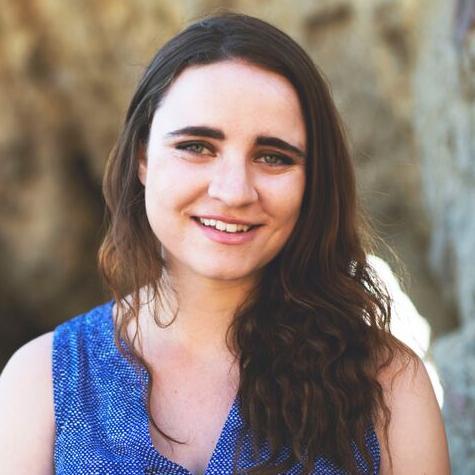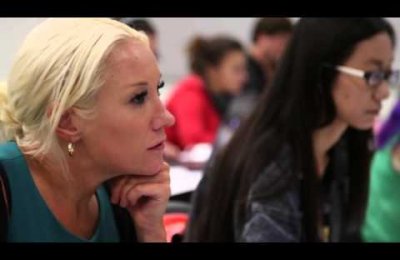With all that the nine-month USC Annenberg Master’s of Specialized Journalism program packs in, it’s no wonder that students have to get a running start on their studies in the summer. For the first three weeks of August, Specialized Journalism students will spend nine hours a day, every weekday, in JOUR 580: Introduction to Specialized Journalism — or what is affectionately known as “boot camp” — getting to know instructors and peers, and familiarizing themselves with multimedia journalism and the city of Los Angeles.
“There’s such a benefit to having students here every day, as opposed to once a week,” Sasha Anawalt, M.A. Specialized Journalism: The Arts program director, said of the two unit course. “We call it boot camp because it’s intense, but we keep it as uncompetitive as possible. The main goal is to have people feel very positive, and possible.”
The Master’s of Specialized Journalism was created as Annenberg’s first nine-month journalism Master’s program in 2008 and is divided into Specialized Journalism with an emphasis on news, and Specialized Journalism with an emphasis on the arts, including film, theater and music. Each student has his or her own area of speciality, and while some students are recent graduates, others already have well-established careers in journalism, the arts or even the medical field.
This year marks the launch of USC Annenberg’s newest nine month Master’s program, the M.S. Journalism Master’s program, which will run its own “bootcamp” for three weeks in the new Wallis Annenberg Hall.
The Specialized Journalism boot camp instructs students in photography, videography, web design and more in order to tell stories about art, music, science, sports and many other topics.
The boot camp’s main instructors are Anawalt, who co-founded the Specialized Journalism Master’s program in 2008, as well as journalist and web developer Peggy Bustamante, who recently joined the USC Annenberg faculty. Grant Slater, a visual journalist who started the photo and video desk at Southern California Public Radio, will serve as the summer course’s multimedia instructor.
Throughout the course, students are tasked with familiarizing themselves with one of three areas of Los Angeles — Highland Park, the Miracle Mile, and Little Tokyo and The Arts District — to scout stories, craft photo essays, create videos, and bring underrepresented people and places in L.A. to life. This all culminates in the LA Story Project, a multimedia website which tells a story as unique as each student.
“We use this model of ‘backpack journalism’ ... to allow students to discover Los Angeles,” Anawalt said.
During the course, students are assigned mentors who often accompany them out in the field, and are also grouped into teams and encouraged to work as classmates and colleagues because, according to Anawalt, “the future of journalism is collaborative.”
The course’s collaborative nature is so critical, Anawalt said, because students come from a diverse variety of professional backgrounds and all have different skill sets which allow them to teach and learn from their peers.
“The ethos of the course is not competitive,” Anawalt said. “Some people might have incredible radio skills, and another person might be a web whiz, so they work together.”
Though students work collaboratively, they’re also individually responsible for each aspect of the course — from scouting stories, writing, reporting and editing, to taking photos, shooting video, and coding basic HTML — which culminates in their very own website featuring their LA Story Project. This approach can push some students out of their comfort zone, but also often results students discovering a passion for a type of journalism they may never have considered.
“Some [students] have never held a video camera, but I can’t tell you how many of them go, ‘I suddenly discovered my voice,’” Anawalt said.
In addition to focusing on telling broader stories about the people and places in Los Angeles, JOUR 580 also emphasizes learning how to profile well. The course begins with each student interviewing a peer and writing a short piece based on that interview.
“The great beauty of that is that you may not boast about yourself, but the other person interviewing you will boast for you,” Anawalt said. “Each person’s story is moving, and you listen to that the rest of the year in your classes, and you respect them because you know their story.”
Another benefit of this exercise, Anawalt said, is that many students get to experience being an interviewee, rather than an interviewer, and are able to develop a sense of best interviewing practices.
One student particularly familiar with interviewing practices is Specialized Journalism (News) student Susan Valot, a 17 year public radio veteran who currently works with NPR and teaches audio production at local community colleges. Valot’s professional experience will allow her to provide valuable input when the course focuses on radio, but as someone with little video production experience and having not worked with print since college, Valot said she’s eager to learn from her peers, as well.
“There’s a wide variety of people and a lot of interplay with a lot of personalities,” Valot, recipient of the Jackson Fellowship for science and technology journalism, said of the course. “Everyone has their own way of doing things, especially in this field, so I think it’s good to get all of those perspectives.”
Some students may have no journalism experience, but are highly trained in other fields of expertise and want to combine multiple interests.
“I always had a double interest in both music and in writing, and I chose to pursue music in high school and as an undergraduate because those are skills you need to cultivate earlier in life,” Elizabeth Nonemaker, a 2012 graduate of the USC Thornton School of Music, said.
Nonemaker learned about the M.A. Specialized Journalism through her mentor, Tim Page, during her time as an undergraduate.
“It was kind of always the plan to do writing after I graduated, and it seemed like the logical thing to do to knit together both music and writing. It’s both an expansion of skills I’ve already learned and a jumping off point into a whole other world for me,” she said. “It’s really inspiring to be around people who are really passionate about what they do.”
At the end of each JOUR 580 course, Anawalt invites back alumni from the past six years of the program, who are able to impart words of wisdom and encouragement upon the students, and even help them to make career connections and find job opportunities.
“The biggest goal of course is for [students] to forge friendships, relationships, and enduring partnerships, to hire each other and work with each other,” Anawalt said. “When they finish those three weeks we want them to feel that they’ve made the best decisions of their lives to be here.”









